In the instrumentation industry, selecting the right material is a critical decision that directly impacts the durability, performance, and cost-efficiency of equipment. Among the commonly used stainless steel materials, SCS14A, SUS316, CF8M, and 316L are well-known for their corrosion resistance and mechanical properties. However, each material has unique characteristics that make it suitable for specific applications. This article provides an in-depth comparison of these materials and their relevance in the instrumentation industry.
Material Overview
1. SCS14A
- Source Standard: Japanese JIS (Japanese Industrial Standards).
- Type: Cast stainless steel.
- Chemical Composition:
- Chromium (Cr): ~19%
- Nickel (Ni): ~9%
- Molybdenum (Mo): 2-3%
- Carbon (C): ≤ 0.08%
- Key Features:
- High corrosion resistance, especially in chloride-rich environments like seawater.
- Excellent castability, making it ideal for complex shapes.
- Commonly used in pumps, valves, and flanges in industrial applications.

2. SUS316
- Source Standard: Japanese JIS.
- Type: Wrought austenitic stainless steel.
- Chemical Composition:
- Chromium (Cr): 16-18%
- Nickel (Ni): 10-14%
- Molybdenum (Mo): 2-3%
- Carbon (C): ≤ 0.08%
- Key Features:
- Good resistance to pitting and crevice corrosion.
- Excellent workability, making it suitable for machining and forming.
- Used in chemical processing, food handling, and marine environments.
3. CF8M
- Source Standard: ASTM (American Society for Testing and Materials) A351/A743.
- Type: Cast stainless steel.
- Chemical Composition:
- Chromium (Cr): ~18%
- Nickel (Ni): ~10%
- Molybdenum (Mo): 2-3%
- Carbon (C): ≤ 0.08%
- Key Features:
- Similar to SUS316 in composition but optimized for casting processes.
- High resistance to corrosion, especially in acidic and chloride environments.
- Widely used in valve bodies, pump casings, and complex geometrical components.
4. 316L
- Source Standard: ASTM.
- Type: Low-carbon austenitic stainless steel.
- Chemical Composition:
- Chromium (Cr): ~16-18%
- Nickel (Ni): ~10-14%
- Molybdenum (Mo): 2-3%
- Carbon (C): ≤ 0.03%
- Key Features:
- Reduced carbon content enhances resistance to intergranular corrosion after welding.
- Superior corrosion resistance compared to SUS316, especially in welded applications.
- Ideal for pharmaceutical, medical, and high-purity environments.

Key Differences and Applications in Instrumentation
1. Corrosion Resistance
- SCS14A and CF8M excel in environments with high chloride concentrations, such as seawater and chemical processes, due to their molybdenum content.
- 316L offers enhanced resistance to intergranular corrosion after welding, making it suitable for applications requiring extensive welding.
- SUS316, while highly resistant to general corrosion, is less suitable for environments with extreme chloride exposure compared to the other three materials.
2. Machinability and Weldability
- SUS316 and 316L are wrought materials, making them easy to machine and weld. 316L, with its lower carbon content, is particularly advantageous for welded structures exposed to corrosive environments.
- SCS14A and CF8M, being cast materials, are not as easily machinable but are excellent for manufacturing complex shapes.
3. Mechanical Properties
- CF8M and SCS14A are better suited for high-strength applications due to their cast structure.
- SUS316 and 316L offer slightly lower strength but provide excellent flexibility and formability.
4. Cost Efficiency
- SUS316 is the most cost-effective option for applications with moderate corrosion requirements.
- SCS14A and CF8M are slightly more expensive due to their casting process and enhanced corrosion resistance.
- 316L is pricier than SUS316 due to its lower carbon content and superior weldability.
Recommendations for Instrumentation Applications
1. Instrument Housings
- Recommendation: SUS316 or 316L.
- Rationale: These materials offer good corrosion resistance and can be easily machined into the required shapes. For environments with welded structures or high corrosion risk, choose 316L.
2. Pressure Sensors and Diaphragms
- Recommendation: 316L.
- Rationale: The low-carbon content ensures high corrosion resistance in welded components, which is critical for long-term reliability in precision instruments.
3. Valves and Pump Components
- Recommendation: SCS14A or CF8M.
- Rationale: These materials are ideal for complex geometries and high-strength requirements, especially in corrosive fluid handling systems.
4. Connectors and Piping
- Recommendation: SUS316.
- Rationale: Cost-effective for non-welded components with moderate corrosion resistance requirements.

Conclusion
In the instrumentation industry, material selection depends heavily on the application environment, manufacturing process, and cost considerations. SUS316 provides a versatile and cost-effective option for most general applications. For demanding conditions involving welding or high chloride exposure, 316L is preferred. When cast components with complex geometries are required, SCS14A or CF8M are the materials of choice. Understanding these distinctions ensures optimal performance, reliability, and cost-efficiency for instrumentation solutions.
